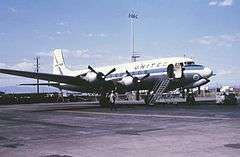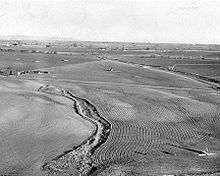United Airlines Flight 629
United Airlines Flight 629, registration N37559, was a Douglas DC-6B aircraft also known as "Mainliner Denver", which was blown up with a dynamite bomb placed in the checked luggage on November 1, 1955. The explosion occurred over Longmont, Colorado, United States at about 7:03 p.m. local time,[2] while the airplane was en route from Denver, Colorado to Portland, Oregon and Seattle, Washington. All 39 passengers and 5 crew members on board were killed in the explosion and crash.[2][3]
 A United DC-6 at Stapleton Airport, similar to the aircraft involved | |
| Bombing | |
|---|---|
| Date | November 1, 1955 |
| Summary | Bombing |
| Site | Longmont, Colorado, U.S. 40°12′0.51″N 104°57′21.96″W |
| Aircraft | |
| Aircraft type | Douglas DC-6B |
| Aircraft name | Mainliner Denver |
| Operator | United Airlines |
| Registration | N37559 |
| Flight origin | LaGuardia Airport, New York, New York |
| 1st stopover | Chicago Midway International Airport, Chicago, Illinois |
| 2nd stopover | Stapleton International Airport, Denver, Colorado |
| 3rd stopover | Portland International Airport, Portland, Oregon |
| Destination | Seattle-Tacoma International Airport, Seattle, Washington |
| Occupants | 44 |
| Passengers | 39 |
| Crew | 5 |
| Fatalities | 44[1] |
| Survivors | 0 |
Investigators determined that John "Jack" Gilbert Graham was responsible for bombing the airplane to kill his mother as revenge for his childhood and to obtain a large life insurance payout.[3][4] Within fifteen months of the explosion, Graham—who already had an extensive criminal record—was tried, convicted, and executed for the crime.[3]
Flight and explosion
United Airlines Flight 629 had originated at New York City's La Guardia Airport on November 1, 1955 and made a scheduled stop in Chicago before continuing to Denver's Stapleton Airfield and landed at 6:11 p.m., eleven minutes late.[2] At Denver the aircraft was refueled with 3,400 US gallons (13,000 L) of fuel, and had a crew replacement.[2] Captain Lee Hall, a World War II veteran, assumed command of the flight for the segments to Portland and Seattle.
The flight took off at 6:52 p.m. and at 6:56 p.m. made its last transmission, stating it was passing the Denver omni.[2] Seven minutes later, Stapleton air traffic controllers saw two bright lights suddenly appear in the sky north-northwest of the airport. Both lights were observed for 30–45 seconds, and both fell to the ground at roughly the same speed.[2] The controllers then saw a very bright flash originating at or near the ground, intense enough to illuminate the base of the clouds 10,000 feet (3,000 m) above the source of the flash.[2] Upon observing the mysterious lights, the controllers quickly determined there were no aircraft in distress and contacted all aircraft flying in the area; all flights were quickly accounted for except for Flight 629.[2]
Numerous telephone calls soon began coming in from farmers and other residents near Longmont who reported loud explosions and fiery debris falling from the night sky—the remains of Flight 629. Ground searchers who reached the crash site determined that all 44 people aboard the DC-6B had died instantly. The debris from the accident was scattered across six square miles of Weld County.[2]
Extensive in-air breakup of the entire aircraft had occurred, and major portions of the wings, engines, and center sections were found in two craters 150 feet (46 m) apart.[2] The large load of fuel ignited on impact, according to fire patterns.[2] The fires were so intense that despite efforts to extinguish them they continued to burn for three days.[2]
There was early speculation that something other than a mechanical problem or pilot error was responsible, given the magnitude of the in-air explosion.[2] The November 2 edition of The New York Times reported a witness to the tragedy describing what he heard: "Conrad Hopp, a farmer who lives near the crash scene, said he and members of his family 'heard a big explosion — it sounded like a big bomb went off and I ran out and I saw a big fire right over the cattle corral. I hollered back to my wife that she'd better call the fire department and ambulance because a plane was going to crash. Then I turned around and it blew up in the air.'"

Victims
All 44 people aboard the aircraft were killed. The ages of the victims ranged from 13 months to 81 years.[5]
Investigation
The investigation, by the Civil Aeronautics Board, determined that the aircraft began to disintegrate near the empennage, or tail, and that the aft fuselage had been shattered by a force strong enough to cause extreme fragmentation of that part of the aircraft. The explosion had been so intense that investigators thought it unlikely to have been caused by any aircraft system or component. There was also a strong smell of explosives on items from the number 4 baggage compartment (which was at the back).
Suspicions that a bomb had been placed in luggage loaded aboard the aircraft were fueled by the discovery of four pieces of an unusual grade of sheet metal, each covered in a gray soot. Further testing of the cargo pit showed that each piece was contaminated with chemicals known to be byproducts of a dynamite explosion,[2] the origin of which was believed to be a passenger's luggage.[6]

The Federal Bureau of Investigation, certain that the aircraft had been brought down by a bomb, performed background checks on the passengers.[3] After the initial checks, they focused their efforts on Denver locals citing that they may have personal enemies.[7]:39 A few passengers had purchased life insurance at the airport just before boarding.[3] One such insuree, as well as local, was Daisie Eldora King, 53, a Denver businesswoman who was en route to Alaska to visit her daughter. When agents identified her handbag, they found a number of newspaper clippings containing information about King's son, John Gilbert Graham, who had been arrested on a forgery charge in Denver in 1951. Graham, who held a grudge against his mother for placing him in an orphanage as a child, was the beneficiary of both her life insurance policies and her will.[3] Agents also discovered that one of Mrs. King's restaurants, the Crown-A Drive-In in Denver, had been badly damaged in an explosion; Graham had insured the restaurant and then collected on the property insurance following the mysterious blast.[3]
Subsequently, agents searched Graham's house and automobile. They found wire and other bomb making parts in the garage, which were identical to those found in the wreckage. They also found an additional $37,500 ($357,900 today) in life insurance policies; however, Mrs. King had not signed either these policies or those purchased at the airport, rendering them worthless.[3][4] Graham told FBI agents that his mother had packed her own suitcase. However, his wife, Gloria, revealed that Graham had wrapped a "present" for his mother on the morning of the day of Mrs. King's ill-fated flight.[3]
Faced with the mounting evidence and discrepancies in his story, on November 13, 1955, Graham finally confessed to having placed the bomb in his mother's suitcase, telling the police:
I then wrapped about three or four feet of binding cord around the sack of dynamite to hold the dynamite sticks in place around the caps. The purpose of the two caps was in case one of the caps failed to function and ignite the dynamite ... I placed the suitcase in the trunk of my car with another smaller suitcase...which my mother had packed to take with her on the trip.
Trial
Authorities were shocked to discover that there was no federal statute on the books at the time (1955) that made it a crime to blow up aircraft.[3] Therefore, on the day after Graham's confession, the district attorney moved swiftly to prosecute Graham via the simplest possible route: premeditated murder committed against a single victim—his mother, Mrs. King. Thus, despite the number of victims killed on Flight 629 along with Mrs. King, Graham was charged with only one count of first degree murder.[3] It was the first trial in Colorado to be televised, and it was covered by KLZ[Note 1] and KBTV.[Note 2]
A motion by the defense attempted to have Graham's confession thrown out on the grounds of Graham not having been made aware of his rights prior to signing it, but the motion was denied.[8] At his 1956 trial, his defense was unable to counter the massive physical evidence and witnesses presented by the prosecution.[8] He was convicted of the murder of his mother and, after a few short delays, was executed in the Colorado State Penitentiary gas chamber on January 11, 1957.[3] Before his execution, he said about the bombing, "as far as feeling remorse for these people, I don't. I can't help it. Everybody pays their way and takes their chances. That's just the way it goes."[6]
Aftermath
As a result of the aircraft explosion, and because there was no law against bombing an aircraft, a bill was introduced and signed by President Dwight D. Eisenhower on July 14, 1956, which made the intentional bombing of a commercial airline illegal.[3]
Graham was reportedly inspired to commit the crime by hearing of a similar incident, the Albert Guay affair in Quebec in 1949. Graham's modus operandi was almost exactly that of Guay's.
United still uses the flight number 629 today on its Washington (National) – Chicago (O'Hare) route.
The bombing of United Flight 629 is depicted in the opening segment of the 1959 movie The FBI Story, starring James Stewart and Vera Miles. Actor Nick Adams portrays Jack Graham.
The bombing is also the subject of "Time Bomb", the fourth episode of season one of Investigation Discovery's series, A Crime to Remember, which first aired December 3, 2013.[3]
Similar incidents
Flight 629 was the second known case of an airliner being destroyed by a bomb over the mainland U.S. The first proven case of sabotage by bomb in the history of commercial aviation occurred on October 10, 1933, near Chesterton, Indiana, when the empennage was blasted from a United Air Lines Boeing 247 by a nitroglycerin bomb triggered by a timing device. The three crew members and four passengers were killed in the crash. No suspect was ever brought to trial in the case.[9]
Other crashes in the United States caused by bombs include:
- National Airlines Flight 2511 over North Carolina on January 6, 1960, killing 34.
- Continental Airlines Flight 11 over Unionville, Missouri on May 22, 1962, killing 45.
See also
Notes
- Now KMGH-TV
- Now KUSA-TV
References
- "Criminal Occurrence Description". Aviation-Safety.net (Flight Safety Foundation). Retrieved January 19, 2016..
- "Civil Aeronautics Board: Accident Investigation Report (File No. 1-0143)". United States Department of Transportation. Archived from the original on 19 January 2016. Retrieved 19 January 2016.
- "Time Bomb". A Crime to Remember. Season 1. Episode 4. Investigation Discovery. Retrieved January 18, 2016.
- "Jack Gilbert Graham". Famous Cases & Criminals. Federal Bureau of Investigation. Retrieved October 21, 2015.
- "Victims en route to varied locations". The Denver Post. October 30, 2005. Retrieved September 28, 2017.
- Bovsun, Mara (May 4, 2013). "Justice Story: Son plants bomb in mom's suitcase, killing her and 43 others during flight". New York Daily News. New York, NY. Retrieved January 19, 2016.
- "A Case for 44 Mid-air Murders". Life. Time Inc. 39 (22): 35–41. November 28, 1955. Retrieved January 16, 2016.
- "FBI History, Famous Cases: Jack Gilbert Graham". United State Federal Bureau of Investigation. Archived from the original on September 2, 2009. Retrieved January 19, 2016.
- https://www.nbcchicago.com/news/local/80-years-later-plane-bombing-remains-a-mystery/1964534/
Further reading
- Field, Andrew J. (2005). Mainliner Denver: The Bombing of Flight 629 (Google books limited preview). Boulder, Colorado: Johnson Books. ISBN 1-55566-363-X.
- Gero, David (1997). Flights of Terror: Aerial Hijack and Sabotage Since 1930. Haynes Publishing. ISBN 1-85260-512-X.